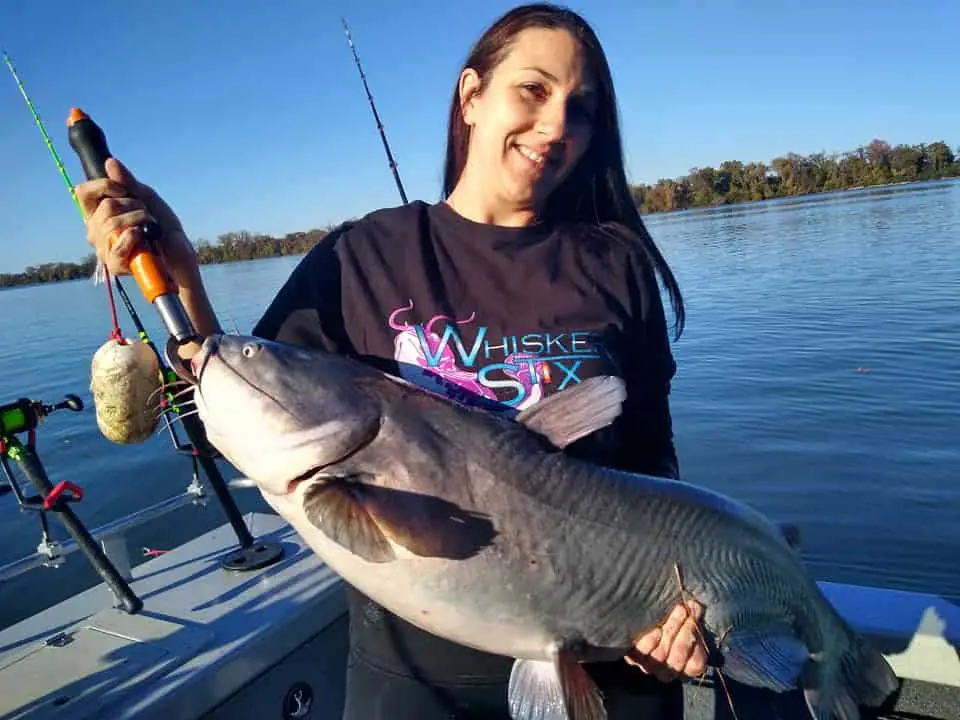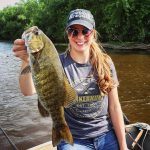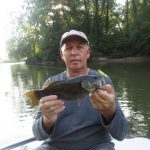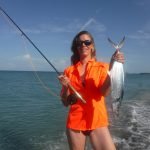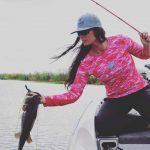12 Useful Blue Catfish Fishing Tips
This article will list 12 useful blue catfish fishing tips. Blue catfish have become a very popular target of anglers throughout North America. They have been successfully introduced into many large river and reservoir systems.
Blue catfish, Ictalurus furcatus, are the largest of the three major catfish species. They are apex predators that grow to 150 pounds. Blue catfish are native to the Mississippi River and it’s tributaries, but have been introduced throughout North America. They adapt well to large reservoir and river systems.
The introduction of blue catfish into some systems is not without controversy. They are a large predator game fish that can change the balance in a particular body of water. Some anglers are not happy with the way they have affected native populations. Fish management agencies introduced blue catfish to offer anglers an opportunity to catch a large, trophy fish.
Blue catfish expert Samantha

Samantha Caudill is an experienced tournament angler and a blue catfish expert. She fishes with her boyfriend Matt Russell. She is sponsored by Dales Tackle, River Rats reel repair, RS Nets, Reel Em Up, BKPC Nation, Fish Hard Industries, Slimecat Rods, and Cat River Anchor. Follow her on her YouTube Channel. Special thanks to her for sharing her pictures and tips!
12 useful blue catfish fishing tips
The following list of 12 useful blue catfish fishing tips will focus on the differences between blue catfish and the other catfish species. While similar in habits, there are some subtle differences in blue catfish behavior and habits. Anglers who understand these factors will be more successful.

1) Proper tackle is important when fishing for blue catfish
Anglers chasing blue catfish will need the proper tackle in order to be successful. In most cases, the rods and reels will be quite a bit heavier than used for other freshwater species. Smaller blue catfish can be caught on lighter tackle, but serious anglers will beef up the tackle quite a bit.
Anglers fishing from boats will do best using fairly heavy conventional tackle. For the most part, casting is not required. Samantha likes a 7′ 3”xmh Slimecat rod foot rod with a Penn Squall 20 reel. Most anglers use braided line, Samantha prefers 40 pound test.
Click to read a detailed article on catfish tackle

Heavy spinning tackle can certainly be used as well, particularly by anglers fishing without a boat. In this application, long casts may be required and spinning tackle is certainly better for that for most anglers. A 7 to 8 foot long heavy rod with a fast action matched to a 6000-8000 series reel is a good all around combo. 40 pound braided line completes the rig.
2) Fresh cut bait is best for blue catfish
The best fishing bait for blue catfish is a fresh chunk of cut bait. Bait fish that are available in the water being fished is best. Herring and shad species in particular are effective as they are quite oily. This helps spread the scent down current and will draw blue catfish in to the bait. Suckers and chubs are also popular. Check local regulations before using fresh caught bait.

Anglers can cut the bait fish into chunks or strips. Chunks, or “plugs” are most often used as they provide more bulk and stay on the hook better. The chunk can be hooked right under the dorsal fin. Serious anglers pursuing blue catfish prefer to catch their own bait. Cast nets are often used. In some areas, traps can be employed as well. Anglers also catch bait using a light rod and small hooks. Again, check local regulations to remain in compliance.
3) Understanding current is a key to success
Current is a very important factor in all types of fishing, and blue catfish are no exception. They thrive in river systems and understanding how current will locate fish is important. Predator fish like to find breaks in the current where they can lie in ambush while not expending a lot of energy.

Anything that causes a break in the current can hold blue catfish and other species. Fallen trees, rock piles, and bridge pilings are examples of this. Ledges are also used by game fish to ambush prey.
Current is extremely important when fishing for catfish in rivers. The spots they will stage in really depends on the level of the river. Entire books have been written on the subject. Basically, when the river is high and fast, catfish will find quiet water out of the main current. Conversely, during low water conditions, they will often be found in the swiftest moving water that has some depth to it.
4) Night time is the right time for catching blue catfish

It is no secret that catfish are nocturnal species. They are built to feed efficiently under almost zero visibility conditions. This included night time as well as very murky water. They use their keen sense of smell more than their sight.
Blue catfish will often move up quite shallow at night as well. Flats that are adjacent to river channels are prime spots. Fish will move out of the depths and up onto the flats to roam about and feet. Obviously, anglers need to be extra careful when fishing in the dark, especially if current is present.

5) Proper rigging for blue catfish is crucial
Fishing for blue catfish is not complicated. However, using the proper rigs and tackle will certainly increase the odds of success. Most often, anglers present the bait on or near the bottom. The basic 3 way catfish rig works very well for this, especially in current.

The Carolina rig is a bit less complicated and is very effective as well. With this rig the line slides through the sinker and a swivel stops it from sliding down to the hook. A float can be added to lift the bait a bit above the bottom. This also gives the bait a natural looking action as it sways in the current. Rattles can be added as well to help blue catfish find the bait.

Most anglers fishing for blue catfish use circle hooks these days. They almost always result in the hook being lodged in the corner of the fish’s mouth. This greatly aids in releasing fish in a healthy state. Sizes vary, but 5/0 is a good all round size for average fish. The hook should be matched to the size of the bait being used. Samantha uses 10/0 circle hooks for most of her fishing that targets larger cats.
There are quite a few choices when it comes to sinkers as well. Samantha, and most catfish anglers, prefer the flat “no roll” sinkers, especially in heaver current. Anglers using 3 way rigs often opt for bank sinkers. Egg sinkers are used when it is desirable to have the bait drifting with the current.

A whisker bomb is a special rig used when precise placement of the bait is desired. With no leader, the bait will not move around and get snagged. This rig is used in heavy cover.
Read more about catfish rigs and baits
6) Top spots for locating blue catfish

Blue catfish are like many other game fish. They prefer structure so that they can ambush prey. The same structure attracts the same forage. Fallen timber, rocks, bridges, channel edges, sloping points and wing dams are all prime examples, Areas that combine two or more of these are prime spots. A channel edge with a steep drop off and fallen timber would be a great example. Blue catfish will get up on a flat to feed as well, particularly at night. Also, generally speaking, blue catfish prefer larger bodies of water. Smaller lakes and rivers will not be as productive.
7) Blue catfish are excellent to eat, but larger fish should be released

Blue catfish are fantastic eating! Their flesh is white, firm, and flaky. Many consider them to be the best table fare of all the catfish species. However, like most fish, the smaller and medium sized fish are best to keep for anglers who desire a meal. Larger blue catfish are usually females. It is important not to over fish the breeder stock.
8) Safety first when handling catfish

Anglers fishing for catfish of any species need to exercise caution when handling them. This is especially true of blue catfish, due to their size. Gloves are highly desired, as is some type of tool to grip a fish in the mouth. The dorsal and pectoral fins have barbs and toxin that are extremely painful if they stab an angler.
9) Other effective baits for blue catfish

While fresh cut bait is the preferred bait for blue catfish, there are several other productive baits. Nightcrawlers will certainly catch blue catfish, as well as just about every other freshwater species. That is actually the main disadvantage to using nightcrawlers and worms. Serious blue cat anglers not not want to be ‘interrupted” by these other fish. For anglers who do not mind, they are an excellent choice. Nightcrawlers are readily available and easy to keep alive.

Prepared commercial baits are very popular among catfish anglers as well, particularly for those targeting channel catfish. However, blue catfish will be caught on these baits as well. The main advantage to using prepared baits is the convenience; they are always in the tackle box and ready to go.
10) Boat position is very important

Boat positioning is crucial to success when it comes to fishing for blue catfish. They will often be found in fairly precise location, though they will also scatter out over a large flat. The key is to place the boat up-current of the spot or area to be fished. Anglers can then put out their spreads as dictated by the conditions. This is a skill that really comes from practice.
Here are some tips on anchoring from Samantha and Matt. Anchor: when anchoring we like to be around 100ft to 120ft from our spot that we marked in our graph. Depending on how deep the water is, is how much rope you will need to let out to keep your anchor in place and so it doesn’t slide. We use a 20lb HD Cat River Anchor with a 150ft rope. When double anchoring we will use one 20lb HD anchor for the front of the boat and 0ne 20lb HD anchor for the back of the boat
11) Blue catfish can be caught from shore

Anglers without a boat can certainly experience success when fishing for blue catfish. This can be done in lakes but is probably more effective when done from a river bank. Fish in rivers are easier to locate. Anglers can access deeper holes on outside bends from the shoreline. Tailwaters (see next tip) are prime spots for blue catfish and many other species. Bridges can offer anglers access as well.
Heavy spinning tackle is usually the best choice for anglers fishing from the shore. However, those proficient with baitcasting tackle can cast just as far, if not further. It is just a bit more difficult, especially for the novice angler.
12) Tailwaters are a top spot for blue catfish

A “tailwater” is the section of a river just below a dam. These are prime locations for anglers seeking many different species, including blue catfish. The current is often swift and catfish will hold behind large rocks and boulders as well as in eddies and current breaks.
Bait fish often get caught in the turbines of the dam and are chopped up and dumped into the flow. This creates a natural “chum slick” of sorts and fish set up to gorge on the easy pickings. Therefore, a chunk of cut shad or herring is tough to beat.
Anglers fishing from shore can often access these areas to fish. Parks are often created in these spots so that kayakers and anglers can access the river. It is VERY important to make safety the top consideration! Water flow levels vary greatly. Most dame have schedules that let anglers know when the water is being released.
These can be great times to fish, but maybe not the best time to be in a small boat. Anglers should never anchor in a heavy current, many have died doing that. Drifting or anchoring downstream and out of the strong current is best. The same applies to anglers fishing from shore; be careful!
In conclusion, this article on 12 useful blue catfish fishing tips will help anglers catch more of these apex predators!
